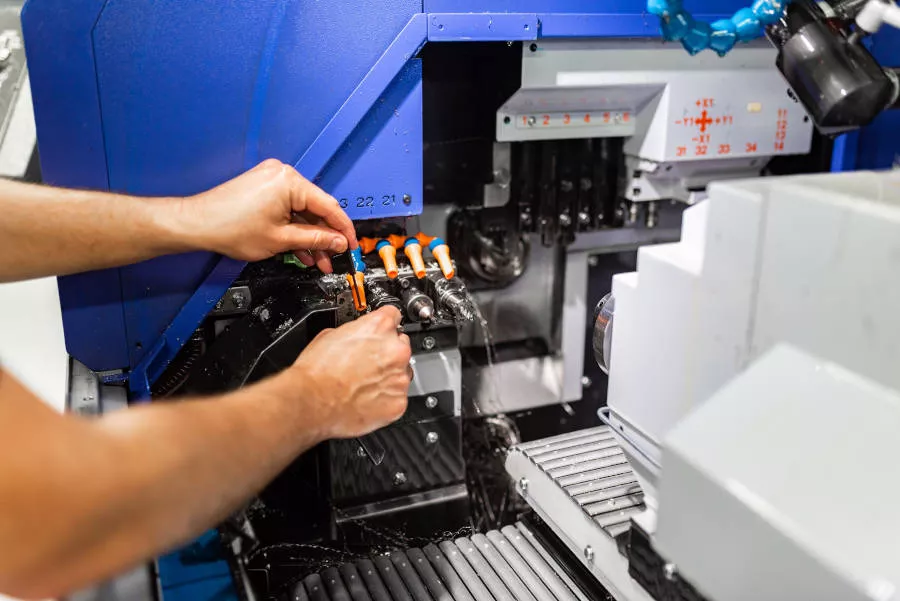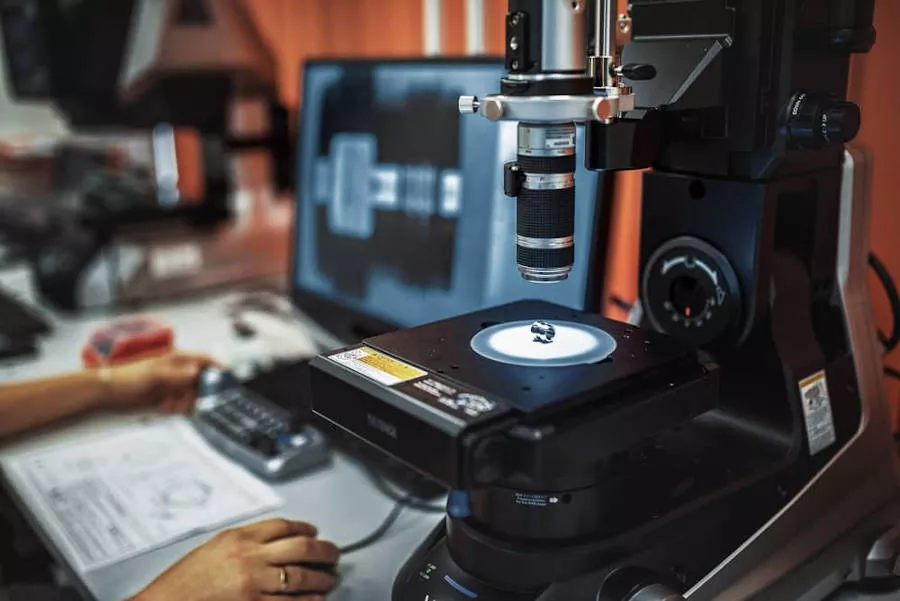CNC Milling - CNC Milling Services
 CNC milling is one of the core branches of TOKAR CNC Technology's business activities. Our offerings encompass technologically advanced solutions in this field, focusing on the production of precise metal components. With years of experience, we can meet the most demanding expectations of our clients, delivering parts of the highest quality and precision.
CNC milling is one of the core branches of TOKAR CNC Technology's business activities. Our offerings encompass technologically advanced solutions in this field, focusing on the production of precise metal components. With years of experience, we can meet the most demanding expectations of our clients, delivering parts of the highest quality and precision.
What Sets TOKAR CNC Technology Apart?
- Utilization of State-of-the-Art Technology: Our CNC machines enable achieving exceptional accuracy and surface smoothness of components.
- Experienced Team: Specialists in CNC machining are ready to tackle the challenges posed by even the most complex projects.
- Comprehensive Milling Services: We provide comprehensive CNC milling services covering diverse materials and component shapes.
- Individual Approach: We tailor our services to the needs and specifications of each project, prioritizing customer satisfaction.
Our Services Include:
- Precision Milling: We guarantee micrometric accuracy and high-quality components.
- Prototyping: We assist in testing and optimizing projects before mass production.
- Small and Medium Batch Production: We handle both small and medium-sized batches of components, ensuring efficiency and cost-effectiveness.
- Complex Projects: We specialize in machining components with intricate geometries, fulfilling even the most demanding orders.
Trust TOKAR CNC Technology as your partner in precise metal machining. Contact us to discuss your needs and receive a custom offer tailored to your requirements. We are confident that we can meet any challenge and deliver excellent results.
CNC Milling: Precision Machining for the 21st Century
CNC milling is an incredibly versatile machining method that has revolutionized many industries. It utilizes numerically controlled machines to precisely shape a variety of materials, from metals and plastics to wood and foams. In this article, we will take a closer look at CNC milling, discussing its essence, the machining process, types of machines, milling stages, benefits, and wide range of applications.
What is CNC Milling?
CNC milling involves removing excess material from a workpiece using a rotating cutting tool called a mill. The mill has blades that cut the material, creating the desired shape. A CNC machine controls the movements of the mill in three or more axes (X, Y, Z, and sometimes A, B, C), ensuring high precision and repeatability of the process.
The CNC Milling Process Consists of Several Stages:
- Designing: At this stage, a 3D model or 2D drawing of the workpiece to be milled is created. This can be done using specialized CAD (Computer-Aided Design) software, allowing for the design of any shape and dimension.
- Programming: A program containing instructions for the CNC machine on how to move the mill and the workpiece is created at this stage. This can be done using specialized CAM (Computer-Aided Manufacturing) software, which automatically generates G-code (the programming language of CNC machines) based on the model or drawing.
- Preparation: At this stage, the CNC machine, tools, and materials for milling are prepared. The CNC machine must be configured and calibrated to ensure proper operation and accuracy. The tools must be selected and mounted in the milling cutter holder. The materials must be properly prepared and secured on the worktable.
- Milling: At this stage, the program is started, and the milling process begins. The CNC machine executes movements according to the G-code and removes material layers from the workpiece using the mill. The milling process can be monitored and controlled using a control panel or computer.
- Quality Control: At this stage, it is checked whether the milled workpiece meets the quality requirements and standards. This can be done using special measuring instruments such as calipers, micrometers, dial indicators, and others. If there are any errors or imperfections, they can be corrected or the workpiece can be rejected.
Benefits of CNC Milling:
- Accuracy: CNC milling allows for achieving very precise and accurate dimensions and shapes, which are difficult or impossible to achieve manually or with other machining methods. CNC milling eliminates human errors and ensures repeatability of results.
- Complexity: CNC milling enables the creation of complex and intricate shapes and patterns, which are difficult or impossible to achieve manually or with other machining methods. CNC milling allows for creating objects from multiple angles and perspectives, with various details and finishes.
- Flexibility: CNC milling allows for easy and quick modification of the design and milling parameters, without the need to change tools or machine settings. CNC milling enables the creation of different versions and modifications of the same object, according to the needs and requirements of the customer.
- Efficiency: CNC milling allows for increasing productivity and saving time and production costs. CNC milling reduces waste and material consumption, improves the quality and durability of products, reduces the risk of machine damage and failure, and increases safety and ergonomics of work.
- Wide Range of Materials: CNC milling can be used for machining a variety of materials, such as metals, plastics, wood, foams, and many others.
Industries Utilizing CNC Milling:
CNC milling is used in many industries, including:
- Machinery Industry: CNC milling is used to create parts and components for machines, equipment, vehicles, bridges, buildings, and other structures. CNC milling allows for achieving high accuracy, strength, and reliability of these parts and components.
- Medicine: CNC milling is used to create implants, prosthetics, surgical tools, medical equipment, and other items used in medicine. CNC milling allows for achieving high quality, biocompatibility, and sterility of these items.
- Aviation: CNC milling is used to create parts and components for airplanes, helicopters, rockets, satellites, and other flying objects. CNC milling allows for achieving high lightness, strength, and aerodynamics of these parts and components.
- Automotive: CNC milling is used to create parts and components for cars, motorcycles, bicycles, and other vehicles. CNC milling allows for achieving high quality, performance, and safety of these parts and components.
- Electronics: CNC milling is used to create parts and components for computers, phones, tablets, consoles, televisions, and other electronic devices. CNC milling allows for achieving high accuracy, functionality, and aesthetics of these parts and components.
Applications in Industry:
CNC milling is a key technology in many industries, where it is used for:
- Prototyping: Rapid and efficient prototyping of new products.
- Mass Production: Manufacturing large quantities of components with repeatable parameters.
- Custom Machining: Creating individual, non-standard elements.
- Modifications and Repairs: Repairing damaged parts and modifying existing designs.
Types of Machines Used:
There are many types of CNC milling machines, differing in size, power, number of axes, and functions. The most popular ones include:
- Conventional Mills: They have 3 axes (X, Y, Z) and are intended for simple machining.
- Contour Mills: They have 4 axes (X, Y, Z, A) and allow for machining more complex shapes.
- CNC Machining Centers: They have 5 axes (X, Y, Z, A, B) and are used for the most advanced machining.
Accuracy in CNC Milling
 The accuracy of CNC milling depends on many factors, which can be divided into three main categories: CNC machine parameters, tools and material, and milling process parameters. Here are the main factors affecting the accuracy of
CNC milling:
The accuracy of CNC milling depends on many factors, which can be divided into three main categories: CNC machine parameters, tools and material, and milling process parameters. Here are the main factors affecting the accuracy of
CNC milling:
1. CNC Machine Parameters:
- Rigidity: The more rigid the machine, the less susceptible it is to vibrations and deformations, resulting in greater accuracy.
- Axis Resolution and Precision: High resolution of axes (X, Y, Z) and precise axis movement affect the accuracy of milling.
- Thermal Stability: The machine should be thermally stable to avoid dimensional changes due to temperature variations.
2. Tools and Material:
- Tool Sharpness: Sharp tools have a greater ability to precisely remove material.
- Tool Quality: Tools made of high-quality materials and precisely sharpened can provide better accuracy.
- Work Material: Different materials have different properties, which can affect machining accuracy. Some materials may be more prone to deformation during machining.
3. Milling Process Parameters:
- Feed Rate and Tool Rotation Speed: Properly selected feed rate and tool rotation speed are crucial for achieving the required accuracy.
- Depth of Cut: Excessive depth of cut can lead to excessive tool wear and reduced accuracy.
- Cooling: Effective cooling of the tool and material can help avoid excessive heating of the tool and material, which can lead to deformation and reduced accuracy.
- Tool Compensation: Automatic tool compensation can be used to correct minor deviations to ensure greater machining accuracy.
Overall, the accuracy of CNC milling depends on the coordinated action of many mechanical and operational factors, which must be carefully controlled and optimized to achieve the best results.
